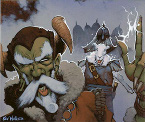Canoerebel
Posts: 21100
Joined: 12/14/2002
From: Northwestern Georgia, USA
Status: offline

|
quote:
ORIGINAL: wpurdom
I was pleasantly shocked a few weeks ago when I discovered you back among the active AAR's. Doubly so when I saw it was a revival of the AAR I had been following in 2013. It has taken me a while to catch up and I have enjoyed reading the history of your war.
Along the way I noted your book recommendations, particularly This Terrible Sound, so I got it and am about 2/3's through - Longstreet has just blown through the hole created by the order for Wood to move his position. I've enjoyed it, but it is definitely a book for Grognards - it takes you field by field, hour by hour, regiment by regiment through the whole disjointed battle. It brings home how little oversight and control there was in the battle, with Bragg and the COnfederate Corps commanders other than Longstreet on the second day, exercising almost no control, and the Union commanders reacting, at best being able to feed in reinforcements haphazardly, a division or brigade at a time. It also collects as many brief snippets or individuals experiences - John Doe seeing his best friend or father killed.
My own nomination for best single battle history from the Civil War is Last Chance For Victory: Robert E. Lee And The Gettysburg Campaign by Scott Bowden and Bill Ward. This book revolutionized my views of the second day at Gettysburg (The treatment of the third day is more questionable). The authors combine going back to contemporary sources prior to the post-reconstruction revisionist bias of persons like Early and Gordon wanting to scapegoat Longstreet (due to his support for reconstruction) along with new research and their own interesting analysis. Meanwhile on the Union side the glorious charge of the 20th Maine at Little Round Top has warped deeper anaysis of the second day). [To sum up, Longstreet becomes the faithful executioner of Lee's concept which works well until Billy Mahone fails to follow orders and AP Hill and Anderson failed to exercise the same oversight as Longstreet and his divisional commanders.] The book has a good and reasonable, though disputable take of the first day and the Stuart raid, a superb treatment of the second day, and a questionable take on the third day, but net is the best battle book of the war in my opinion, and the only one to make me change my fundamental understanding of a civil war battle in 40 years.
Sorry if this seems off-topic and out of place to the current discussions, but I felt it was sufficiently in line with the general tenor of Canoerebel AARs.
Thanks for the tip, wpurdom. I'm glad you found your way back.
This Terrible Sound is definitely a grognard (AE) level book. It no doubt helps to have a working knowledge of the terrain, else it's like an American trying to read Doctor Zhivago: Is it 13 kilometers or 2,000 kilometers from Grognivostok to St. Ravensburg? But above all I love all the insights into the thoughts of the fighting soldiers.
Compare Cozzens's works to that of a newcomer, named Powell. Powell does magnificent research and then packs all the information into his books. But that makes his writing clunky and rather dry. Cozzens, in comparison, is concise and powerful.
|
 Printable Version
Printable Version



















 New Messages
New Messages No New Messages
No New Messages Hot Topic w/ New Messages
Hot Topic w/ New Messages Hot Topic w/o New Messages
Hot Topic w/o New Messages Locked w/ New Messages
Locked w/ New Messages Locked w/o New Messages
Locked w/o New Messages Post New Thread
Post New Thread